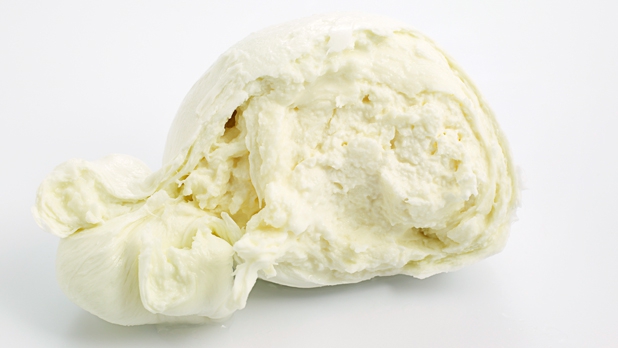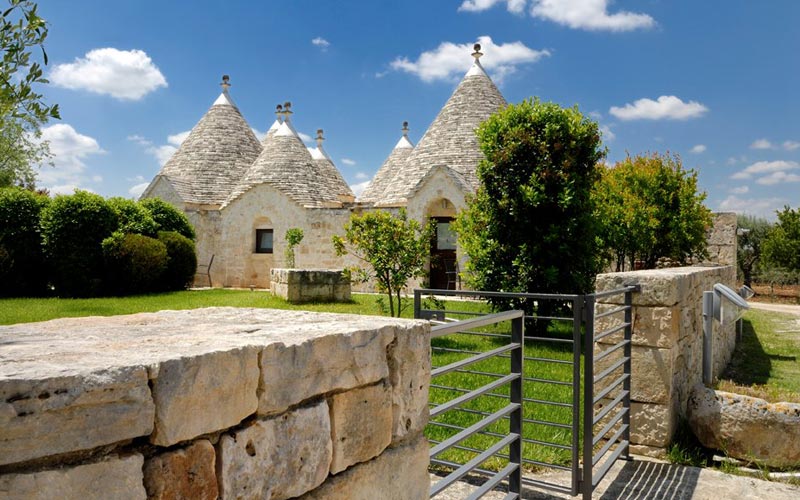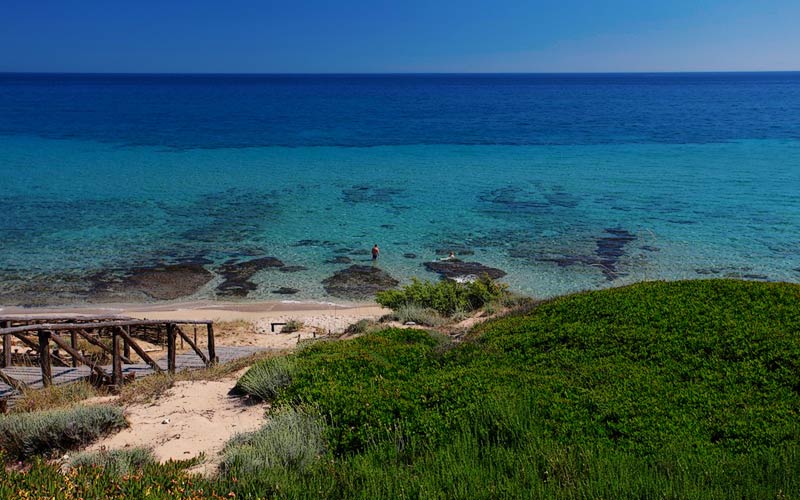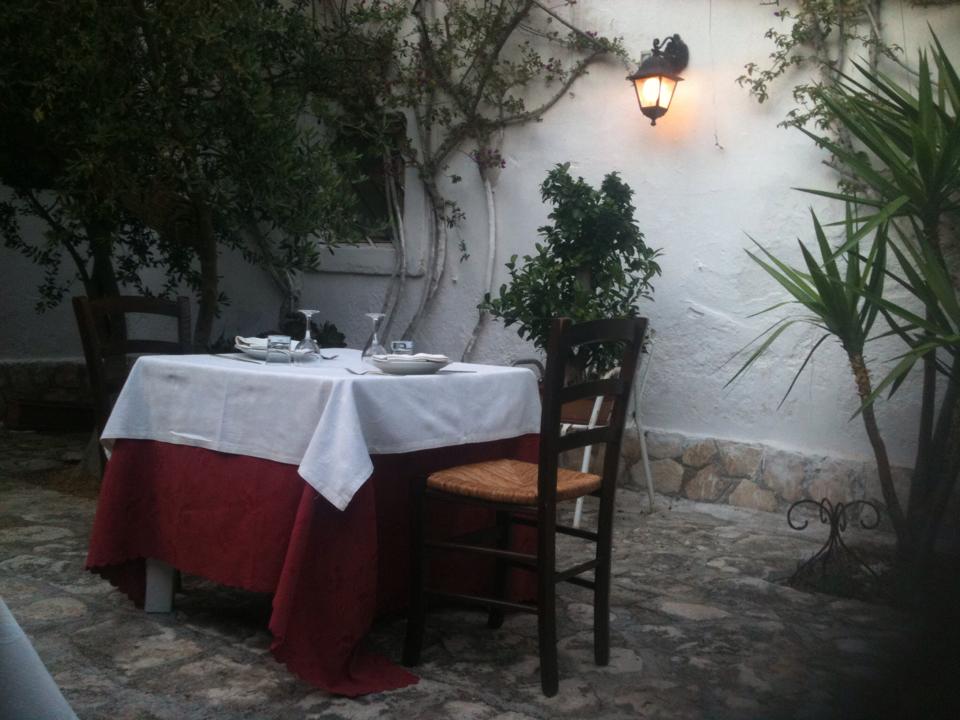


文/朱文俊 图/东方IC
在香港几十年,靠着冷藏技术及运输发达,习惯了什么食材都是手到擒来,逐渐,忘记了不时不食的基本法则;甚或自以为可以掌控环球食材时序而沾沾自喜。直至走了一趟意大利南部的普利亚(Pugila),位置就在意大利靴形地图的鞋跟处,此地三面环海,主要食材为四时的农作物、就地取材的海鲜,肉食的菜式是少之又少。因缘际会,让我这次旅程,得以开展一段无“肉”清修,味蕾寻回旧日纯粹感觉。
一直认为意大利人跟中国人有很多相似地方,其中饮食习惯是最为明显的。先谈面食,据说山西面食多达四百种,而意大利亦据说有三百五十多款;今次我在Manduria(曼杜里亚)试过其中一款他们的代表面条Orecchiette(意大利语即为小耳朵),外形跟我们的猫耳朵十分近似,可荤可素,但在普利亚无肉才是王道,简单的做法可以用罗勒略炒,加上日晒干辣椒,拌入干酪,再用小盆烤烘上桌,当地人称谓家乡做法。另一款亦是常见的做法是用萝卜菜头切碎来炒,卖相有点像江浙菜的荠菜炒年糕;当然,单单用日晒西红柿、罗勒、茴香加干酪已是很好的材料,配搭是止于你的想象。
个人认为吃Orecchiette宜带点禅意,品尝的正是面食麦香、面条的韧度(嚼劲),余者皆是虚幻。因此,我个人的做法是:把面条煮至九成熟,趁热拌入初榨橄榄油、刨硬干酪、洒意大利混合香草、略磨黑胡椒,泡清茶一杯,碧螺春可以,青普亦佳。还有,做Orecchiette必须为粗硬小麦,幼细的面粉,便俗了。

Do we know anything sexier than burrata?
That misshapen, white shell of buffalo milk mozzarella that cradles and embraces the soft insides of curd and fresh cream is some inspired combination of artistry and sun-baked, Southern Italian food tradition. A serated knife slides in, and scraps of mozzarella and panna (buttery cream) escape- a fig, a tomato or a piece of focaccia quick to sop up the goodness. It’s sexy, humble, imperfect-looking on the fork– though gorgeous on the tongue– and it might just be the reason we’re flying 4,500 across the ocean and down the Italian coast to Puglia, “the heel of the boot.”

This is the land of trulli, “white-washed teepees made of limestone” that date back to the Middle Ages…

countryside that produces Negroamaro and Primitivo, the grape cousins of California’s Zinfandel (pictured above, the vineyards and main house at Masseria Le Fabriche , where we will be staying for part of our time in Puglia)…

…and crystalline-blue seas, whether on the Adriatic or Ionian Sea side, where the water is appreciated as much for its beauty as the food it yields. Ricci (sea urchin), polipo(octopus) , scampi (large shrimp) and fish will taste wonderfully new to us, something like a nightly flavor experiment, saltier and more richly flavored than what we know from the Atlantic and the Gulf of Mexico. (Pictured above, D’Ayala Beach, part of a protected marine reserve and a 5-minute bike ride from our hotel )

Down here, in the extreme South, the women run the kitchen. The raviolo with fresh marinara, fried chickpeas and eggplant pictured above? Yep, made by the ladies at Le Fabriche .

And here’s our table for two, at Masseria Ottava Piccola, where Maria Valentini- a truemaestra of the local cuisine- will serve us her famous spread of antipasti (freshly picked tomatoes, eggplant and zucchini simply prepared then plated with fresh burrata and ricotta), handmade orecchiette pasta, wild asparagus and whichever cut of wild game looked best at the butcher’s. Her son, and my dear friend, Silvestro will drizzle it all with his bright green olive oil, made from the press out back, and insist on bringing out another bowl of handmade taralli. The next day, we have a cooking lesson booked in Maria’s kitchen, an attempt to learn a few of her secrets.
Puglia is sexy, southern, sun-drenched– and it looks to be our most delicious foodie vacation yet. Here’s our Puglia Guide to (you guessed it!) eating and drinking very, very well. (I mean, really, where else on Earth can you enjoy a still-warm ball of fresh burrata and sea urchin on-the-half-shell, freshly plucked from the ocean??) We’ll also take in a few churches and museums along the way. After Puglia, we’re on our way to Amalfi…
PUGLIA by The Couples Kitchen
Sleep
Lecce: Dimora San Giuseppe (*Great Value)- Smack dab in the middle of Lecce’s Baroque beauty, Dimora San Giuseppe looks to offer a chic B&B experience within the walls of a centuries-old Palazzo Libertini. Spa bathrooms and complementary breakfast room service with fresh breads, homemade jams and steaming hot coffee elevate this B&B to the next level. Near Piazza Sant’Oronzo and a half dozen other historical sites, we’re looking forward to stepping outside the hotel and being in the middle of all the action- action here, of course, meaning wine bars, artisanal pastry shops, Baroque churches and insanely delicious al fresco restaurants. Marco, the owner, has been very helpful booking rooms and suggesting restaurants.
Fasano: Masseria Ottava Piccola (*Great Value)- Ottava Piccola is the real deal, a working farmhouse nestled within the olive groves and white-washed beauty of Eastern Puglia. Brooke has known the incredibly warm Valentini family for 15 years and has always been welcomed into their home as a daughter. Silvestro hosts and runs the masseria while Mama Maria explores and maintains Puglia’s extraordinary culinary traditions from her post in the garden and the kitchen. “Tutto casereccio!” is Maria’s modus operandus and man-oh-man is that a good thing. Lunch on the terrace and dinner under the pergola will be the highlights while we’re with Silvestro and family. Aware of Brooke’s insane love and devotion for Pugliese cheeses, Silvestro has arranged for us to take a burrata-making class at a neighboring caseificazione (cheese making shop). Stay at Ottava Piccola and stay with family.
Maruggio: Hotel Le Fabriche - As stylish and serene as they come. Working off a tip from Brooke’s best friend, Ellen, who lives in Rome, Le Fabriche jumped off the computer screen and onto our Puglia itinerary before we could say “Primitivo di Manduria.” Yep, Primitivo is the prized local grape and what we’ll literally be waking up to every morning, the grape vines rustling beneath our window and calling us outside for one of the owners unforgettable Puglian breakfasts. The vaulted ceilings, stone floors and neutral hues of the refurbished 17th-century home make this one of the most elegant relais in all of Puglia. Marilisa, the warm and wonderfully capable assistant and concierge has set up a wine and olive oil tasting for us on the property. She has also organized several winery visits in the area as well as bike tours to the local beaches and seaside nature preserve.
Manduria: Masseria Potenti - While we won’t be staying at Potenti, we will be attending a wedding here. Nestled between Manduria and Avetrana, surrounded by olive groves and ancient walls, this masseria looks to be pretty spectacular. Originally belonging to the very wealthy Imperiali family, Potenti is now one of the area’s most scenic and “hands-on” bed & breakfasts, with guests able to assist the owners with harvesting grapes, olives and fruit from the property. There is also a large vegetable and herb garden, the ingredients which play a starring role in Potenti’s cooking lessons and evening meals. Sign us up!
Eat/Drink
Lecce: Doppiozero- Puglia’s totally amazing version of a deli, ready to feed you now, later and maybe on the plane ride back to the States. Local meats, cheeses and wines are ready for take-out as are a few cold salads. A lunch menu of small plates lets you sample the best Apulian flavors while dining al fresco in the cobblestoned piazza. We’ll do a loop and check out the goodies stacked along the walls- local pastas, olive oils and wines- that we’ll bring home to Jamie’s mom for taking care of Parker for two weeks! We imagine our tiny rental car will be perma-parked outside of DoppioZero.
Persone’ (Wine Bar/Aperitivo Hour)- Persone’ is supposed to be one of the most elegant wine bars in town, located within the ancient walls of the palazzo that houses the namesake hotel. The sleek underground wine bar is marked by gorgeous archways, the architecture rivaling the long and impressive wine-by-the-glass menu.
Mama Elvira Enoteca (Wine Bar/Aperitivo Hour)- Championing everything artisanal and local, Mama Elvira is probably our sophisticated-yet-casual happy hour dream come true. Another friend who lives in the area recommended the enoteca as much for its food & wine list as the ambiance (Click here for pics). Prediction: We’ll enjoy our plates of eggplant parmesan, burrata and housemade charcuterie so much that dinner will be an afterthought. To note, locals say this is the best place to sample the area’s Negroamaros.
Le Zie (Restaurant)- At how many restaurants do you ring the bell before a matronly “aunt” opens the door and welcomes you to her dining room for a multi-course, homemade dinner? (Aunt – “zia,” plural- “zie” in Italian) That’s what you get at Le Zie, or Trattoria Cucina Caserrecia, where even the locals come for classics like fave e ciccoria (fava bean puree & sautéed chicory greens), tiella di riso (rice, mussels, potatoes, zucchini) and handmade pastas simply prepared with seasonal vegetables. Check those skinny jeans at the door.
Corte dei Pandolfi (Restaurant)- If it’s good enough for the New York Times Travel section, it’s good enough for us. In the Times’ “36 Hours in Lecce” feature, Corte dei Pandolfi enjoys fantastic reviews for their “appetizer of scamorza cheese… baked to gooeyness and wrapped in crisp pancetta strips. [And for] the mains, carnivores should consider the costata di vitello. Sliced from a thick veal chop, the chunks of pink meat are robust enough for a Viking, almost soft enough to slice with a spoon.” We bet Jamie will be alternately eating and furiously scribbling down tasting notes.
Other Fabulous Meals Around Puglia (Fasano, Ostuni, Maruggio, Manduria, etc): Brooke has booked B&B’s (locally known as “masserie”) as much for their rooms-with-a-view as for the breakfasts, lunches and dinners that are prepared nightly, on-property by the lady chefs. The one time when we’re venturing beyond our hotel- but for one meal only- is when we’re with the Valentini Family at Ottava Piccola. While Maria Valentini is the master of her garden and all things “land,” her nephew is king of the sea with hisPescheria Due Mari in nearby Savelletri. The locals swear up and down that Due Mari serves the best pesce crudo (sashimi) this side of Japan. Tuna, scampi, oysters, sea urchin and local white fish are caught from the Adriatic that lies right before the restaurant, and then sliced at the al fresco bar. Jamie’s wagering Due Mari will become Brooke’s new obsession and figure into an upcoming girls trip to Italy.
Wine-ing It
Movimento del Turismo Vino in Puglia. is a non-profit organization that strives to bring serious winos and foodies (like us) to Puglia and to bring the region to the forefront of wine-focused travel, much like occurred in Tuscany in the 1970′s. MTV, as they call it, is all about helping Puglia’s wine culture develop ergo helping what has historically been one of the poorer regions in Italy. Brooke and MTV have chatted extensively about our itinerary. From there, Brooke selected the following wineries:
Leone de Castris (in Salice Salentino)- Leone de Castris was the first winery to bottle Puglian wine in 1925, and in 1943 there was another “first”, when it created the first Italian Negroamaro rosé wine – “Five Roses” – which has helped to bring this grape variety to the attention of the rest of the world. The imposing winery building has a very old barrel cellar with a high vaulted ceiling, and a well-equipped wine-tasting room. Visitors will also enjoy seeing the Wine Museum dedicated to the memory of two of Puglia’s important wine-growers – “Piero and Salvatore Leone de Castris”.
Albea (in Alberobello)- Albea is one of the region’s best known wineries, founded in 1905 now belongs to Dante Renzini, and is situated next to the railway line which used to transport local grapes and grape must abroad. This modern winery expresses well the ancient wine-growing traditions of the Itria Valley. Albea is a name evoking the ancient name of Alberobello. The winery hosts an interesting Wine Museum on its upper floor, a growing collection of farm implements and photographs revealing centuries of agricultural traditions. Here you can taste the interesting white wines of Itria Valley together with the classic Puglia reds.
Felline (in Manduria)- This project is the brain-child of Gregory Perrucci, dedicated to valorisation of Puglia’s wine-making heritage and the region’s wines with their unmistakable bouquets. The Accademia has a modern approach and promotes the region’s wines abroad. The young and highly-motivated staff have made it possible to achieve some important objectives, such as the recuperation of Susumaniello and Ottavianello, two varieties which were nearing extinction. Primitivo is the dominant variety in this winery, and other varieties grown s include Malvasia nera and Negroamaro, made into single-variety wines or else used in innovative blends. The owner is happy to welcome guests and share with them the tradition of Primitivo, an integral part of the winery’s history.
Moros (in Guagnano)- Claudio Quarta has founded this very small winery – Moros – in order to give expression to Negroamaro in one of its most prestigious denominations, Salice Salentino. The winery is at Guagnano, the epicentre of this Dop. Moros uses mostly Negroamaro grapes and also Malvasia Nera, grown in a small vineyard of just 1,3 hectares on the edge of the town.
Consorzio Produttori Vini (in Manduria)- The WINE MUSEUM! You bet this is one exhibit we will not miss ![]() !
!

di Elyse Glickman
Puglia's most successful wineries are reaching a more sophisticated market with a greater emphasis on its terroir and grapes.
Puglia's wine industry is one a with a past - for better and worse. Its wine production, whose history dates back to antiquity, accounts for 17 percent of Italy's total production.
read more >>

di Eddie Chui
The world most renowened wineries of Italy are usually coming from the Tuscany in the central area an Piemonte, Friulia, etc in the north. The wines from the south are generally regarded as table wines. in fact those winery in the north has been evolving and improving in the past few decaded to gain such recognition. In the last 20 years, many wineries in the south were taking great steps. We traveled earlier to Puglia to explore the new movement of the wineries there to see the changes of those traditional and newly established wineries, which are famous for the Primitivo grapes.
read more >>

written by Max Gross
Puglia, in the south of Italy, has wineries like Tormaresca in the Castel Del Monte area. If your doctor has ever told you about the healing power of wine, head to the heel. We’re talking about Puglia, the region jutting out at the heel of Italy’s boot, nestled between the Adriatic and Ionian Seas. Puglia is a little more rustic than other parts of Italy. Its major cities like Bari, Lecce and Trani are a lot smaller and less trafficked by tourists than, say, Milan or Venice. But what you can sample, instead, are some quality, inexpensive wines (most are less than 20 euros), in the country’s third biggest wine-producing region, which boasts about 30 different indigenous grapes. There are big and small wineries operated by friendly Italians that are free and open to the grape-guzzling public (although one should call before stopping by, they all advise). In San Pancrazio Salentino is the Tenute Mater Domini winery, which opened in 2003 and offers an array of reds, whites and rosés, our favorite being the Casili — red wine that is 95 percent Negroamaro, one of the most popular local grapes. After lunch in Lecce — try Persone, an underground restaurant, bar and B&B in a former synagogue that offers a buffet of pastas, vegetables and salumi at extremely reasonable prices — the effects of the alcohol you drank might have worn off. We suggest getting your buzz back at Leone de Castris, one of the oldest wineries in Puglia (it dates back to 1665), which is also the first winery to use the Negroamaro to make a rosé. Called Five Roses, it’s 90 percent Negroamaro, 10 percent Black Malvasia grapes. Unlike many others in Puglia, this winery is decked out with portraits and busts of former owners, and on the second floor of the building they’ve adorned their tasting room with old wine presses. After giving their Five Roses a sip, we recommend the Salice Salentino 2009 Riserva, an almost smoky red (also a 90/10 split of Negroamaro and Black Malvasia) with hints of blackberry, black cherries, basil and spice. And there are other rosés worth trying. Mottura, a winery in a 19th-century country house, offers a pink rosé one of their Le Pitre brand wines, which has nice fruitiness (a little strawberry? a little cherry?) and crispness. Of course, Puglian wine is not all Negroamaro. At the Vigne & Vini winery there are some excellent Primitivo wines (Primitivo being a genetic clone of the Zinfandel). Their Moi Primitivo Puglia has, along with its red fruit, hints of plum jam and licorice. Some of the wineries are bigger and more grandiose than others, and one definitely gets a sense of the vastness of these (and just how big an industry wine is) walking amongst the 1,000 or so oak barrels in Bocca di Lupo’s cask room. Bocca di Lupo (“mouth of the wolf”) is one of two estates that the wine producer Tormaresca has, and the one in Puglia is in the Castel Del Monte region. Try their Aglianico, a black grape, originally from Greece, which yields a rich, peppery, nicely acidic red wine. Hopping from winery to winery, one sees how lush the landscape is; the fields are crammed with vineyards and olive trees. One of the best ways to take this all in is to spend your days at one of the country farmhouses known as masserias. Masseria Potenti (from 160 euros) is a 12-suite compound deep in a green, rustic area near Taranto in the middle of the region (but not so rustic that it didn’t have a swimming pool). In Trani, Corteinfiore (from 70 euros) is both a six-room hotel and a restaurant, offering excellent pastas and seafood. And don’t miss the Rivera winery, which is run by the president of the Puglia wine consortium, Sebastiano de Corato, whose grandfather started the winery 60 years ago. Take a sip of the Puer Apuliae, a rich, Nero di Troia red wine, or the Cappellaccio, an Aglianico, and you’ll be knocked off your heels.
New York Post
(24 / 09 / 2013)